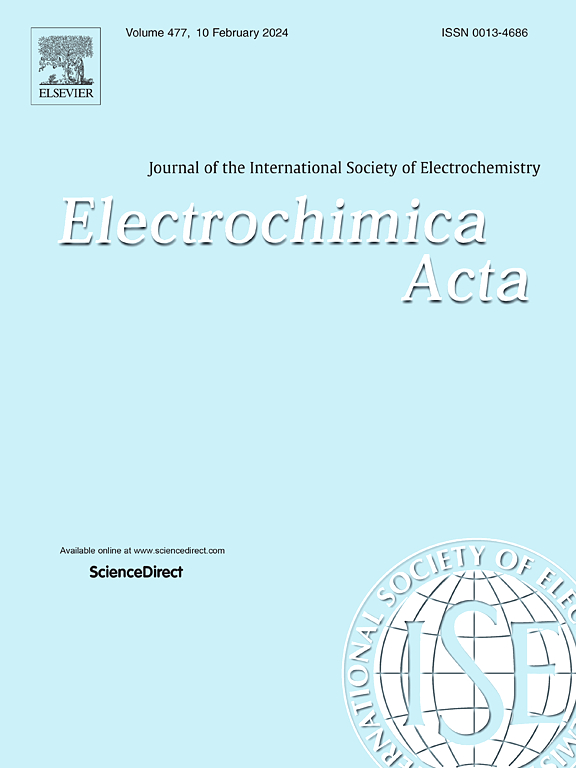通过结构失序增强Ti3C2Tx MXene和pva衍生碳复合气凝胶的电容储能能力
IF 5.6
3区 材料科学
Q1 ELECTROCHEMISTRY
引用次数: 0
摘要
MXene 材料具有高比表面积、可调的层间间隔和出色的导电性,因而具有强大的储能能力。然而,这些层容易重新堆积,从而对材料的储能能力产生负面影响。在这里,通过液氮辅助冷冻干燥和随后的退火过程,Ti3C2Tx 纳米片通过氢键与聚乙烯醇(PVA)聚合物链结合,产生了 MXene 和 PVA 衍生的碳复合气凝胶(MPAs),其微观结构从有序排列到无序排列不等。PVA 的加入抑制了纳米片的堆叠,而 PVA 的碳化增强了气凝胶的导电性。碳化后的气凝胶(MPA2.0)显示出更大的比电容以及更无序、更致密的微观结构,从而说明电容的增加是由于结构更无序的碳纳米孔中离子存储的增强。优化后的 MPA 气凝胶具有很高的功率密度和出色的比电容(MPA2.0 = 348.14 F g-1,扫描速率为 2 mV s-1),在 10,000 次充放电循环后,循环稳定性达到 92.52%。此外,基于 MPA2.0 的超级电容器在电流密度为 1 A g-1 时获得了惊人的能量密度(37.8 Wh kg-1)和超高的功率密度(1800 W kg-1)。通过调整 PVA 的负载量,改变了冷冻干燥和碳化过程中微结构的收缩和应力应变特性,并控制了所得气凝胶的微结构取向。气凝胶中无序度的增加增强了其电容器储能能力,为多组分高性能混合超级电容器电极的设计提供了一种新方法。本文章由计算机程序翻译,如有差异,请以英文原文为准。


Enhancing the capacitive energy storage ability of Ti3C2Tx MXene and PVA-derived carbon composite aerogels through structural disorder
MXene materials exhibit substantial energy storage capabilities owing to their high specific surface areas, tunable interlayer spacings, and excellent electrical conductivities. However, these layers are prone to re-stacking, negatively affecting the energy storage capacity of the material. Herein, through a process involving liquid nitrogen-assisted freeze-drying and subsequent annealing, Ti3C2Tx nanosheets were combined with polyvinyl alcohol (PVA) polymer chains via hydrogen bonding to produce MXene and PVA-derived carbon composite aerogels (MPAs) with microstructures ranging from ordered to disordered arrangements. The incorporation of PVA inhibited nanosheet stacking, and PVA carbonization enhanced the electrical conductivity of the aerogel. The carbonized aerogel (MPA2.0) exhibited a larger specific capacitance along with a more disordered and denser microstructure, thereby accounting for the increased capacitance due to enhanced ion storage in the more structurally disordered carbon nanopores. The optimized MPA aerogel demonstrated a high power density, along with an excellent specific capacitance (MPA2.0 = 348.14 F g−1, 2 mV s−1 scan rate), and a cycling stability of 92.52 % after 10,000 charge/discharge cycles. Furthermore, the MPA2.0-based supercapacitor obtained an impressive energy density (37.8 Wh kg−1) and an exceptionally high power density (1800 W kg−1) at a current density of 1 A g−1. By adjusting the PVA loading, the shrinkage and stress–strain characteristics of the microstructure during freeze-drying and carbonization were altered, and the microstructural orientation of the resulting aerogels was controlled. The increased disorder in the aerogel enhanced its capacitor energy storage ability, providing a new approach for the design of multi-component high-performance hybrid supercapacitor electrodes.
求助全文
通过发布文献求助,成功后即可免费获取论文全文。
去求助
来源期刊

Electrochimica Acta
工程技术-电化学
CiteScore
11.30
自引率
6.10%
发文量
1634
审稿时长
41 days
期刊介绍:
Electrochimica Acta is an international journal. It is intended for the publication of both original work and reviews in the field of electrochemistry. Electrochemistry should be interpreted to mean any of the research fields covered by the Divisions of the International Society of Electrochemistry listed below, as well as emerging scientific domains covered by ISE New Topics Committee.
 求助内容:
求助内容: 应助结果提醒方式:
应助结果提醒方式:


